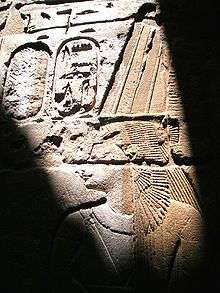Amenirdis I
Amenirdis I (throne name: Hatneferumut) was a God's Wife of Amun during the 25th Dynasty of ancient Egypt.[2] Originating from the Kingdom of Kush, she was the daughter of Pharaoh Kashta and Queen Pebatjma, and was later adopted by Shepenupet I. She went on to rule as high priestess, and has been shown in several artefacts from the period.
| Amenirdis I | ||||||||||||||||||||||||||||||||
|---|---|---|---|---|---|---|---|---|---|---|---|---|---|---|---|---|---|---|---|---|---|---|---|---|---|---|---|---|---|---|---|---|
 Amenirdis in Medinet Habu | ||||||||||||||||||||||||||||||||
| Divine Adoratrice of Amun God's Wife of Amun | ||||||||||||||||||||||||||||||||
| Reign | 714–700 BCE (25th Dynasty) | |||||||||||||||||||||||||||||||
| Predecessor | Shepenupet I | |||||||||||||||||||||||||||||||
| Successor | Shepenupet II | |||||||||||||||||||||||||||||||
| ||||||||||||||||||||||||||||||||
| Father | Kashta | |||||||||||||||||||||||||||||||
| Mother | Pebatjma | |||||||||||||||||||||||||||||||
Biography
She was a Kushite princess, the daughter of Pharaoh Kashta and Queen Pebatjma. She is likely to have been the sister of pharaohs Shabaka and Piye.[2][3] Kashta arranged to have Amenirdis I adopted by the Divine Adoratrice of Amun, Shepenupet I, at Thebes as her successor.[4] This shows that Kashta already controlled Upper Egypt prior to the reign of Piye, his successor.[5]
She ruled as high priestess approximately between 714 and 700 BCE, under the reigns of Shabaka and Shabataka, and she adopted Piye's daughter Shepenupet II as her successor.[2] She also held the priestly titles of Divine Adoratrice of Amun and God's Hand.[6] Upon her death, she was buried in a tomb in the grounds of Medinet Habu.[2]
She is depicted in the Osiris-Hekadjet ("Osiris, Ruler of Eternity") temple in the Karnak temple complex, and in Wadi Gasus, along with Shepenupet I. She is mentioned on two offering tables, five statues, a stela and several small objects including scarabs.[2] A statue of Amenirdis I carved from granitoid and decorated in gold leaf is held by the Nubian Museum in Aswan, Upper Egypt. The statue itself shows her decorated as if Egyptian, with similarities to depictions of Isis and Hathor. However, the physical attributes of Amenirdis on the statue demonstrate a distinct African influence in the Kushite style of the 25th dynasty.[7]
References
- von Beckerath, Jürgen (1999). Handbuch der Ägyptischen Königsnamen (in German). Mainz am Rhein, Von Zabern. pp. 210–11. ISBN 3-8053-2591-6.
- Aidan Dodson & Dyan Hilton, The Complete Royal Families of Ancient Egypt, (London: Thames & Hudson, 2004) ISBN 0-500-05128-3, p.238
- Shaw, Ian (2003). The Oxford History of Ancient Egypt. Oxford University Press. p. 347.
- Peden, Alexander J. (2001). The Graffiti of Pharaonic Egypt: Scope and Roles of Informal Writings (c. 3100–332 B.C.). Brill Academic Publishers. p. 276.
- Török, László (1997). The Kingdom of Kush: Handbook of the Napatan-Meroitic Civilization. Brill. p. 149.
- Bart, Anneke. "Ancient Egypt". Saint Louis University. Archived from the original on 4 October 2016. Retrieved 3 November 2016.
- "Statue of "The Divine Adoratrice of Amun" Amenirdis I". UNESCO. Archived from the original on 4 November 2016. Retrieved 3 November 2016.
Further reading
- Ayad, Mariam F. "The Selection and Layout of the Opening of the Mouth Scenes in the Chapel of Amenirdis I at Medinet Habu". Journal of the American Research Center in Egypt, Vol. 41 (2004), pp 113-133.
- Ayad, Mariam F. "The Pyramid Texts of Amenirdis I: Selection And Layout". Journal of the American Research Center in Egypt, Vol. 43 (2007), pp. 71-92. https://www.jstor.org/stable/27801607
- Ayad, Mariam F. God's Wife, God's Servant: The God's Wife of Amun (c. 740–525 BC). Routledge, 2009. ISBN 978-0-415-41170-7.
- Dodson, Aidan. The Problem of Amenirdis II and the Heirs to the Office of God's Wife of Amun during the Twenty-Sixth Dynasty. The Journal of Egyptian Archaeology, Vol. 88 (2002), pp. 179-186. https://www.jstor.org/stable/3822343
- Hays, Harold M. "A New Offering Table for Shepenwepet". Journal of the American Research Center in Egypt, Vol. 40 (2003), pp. 89-102. https://www.jstor.org/stable/40000292
- Kitchen, Kenneth, The Third Intermediate Period in Egypt (1100–650 B.C.), 2 Sub edition. Aris & Phillips, 1996. ISBN 0856682985.
External links
| Wikimedia Commons has media related to Amenirdis I. |
| Preceded by Shepenupet I |
God's Wife of Amun | Succeeded by Shepenupet II |
| Preceded by Shepenupet I |
Divine Adoratrice of Amun | Succeeded by Shepenupet II |